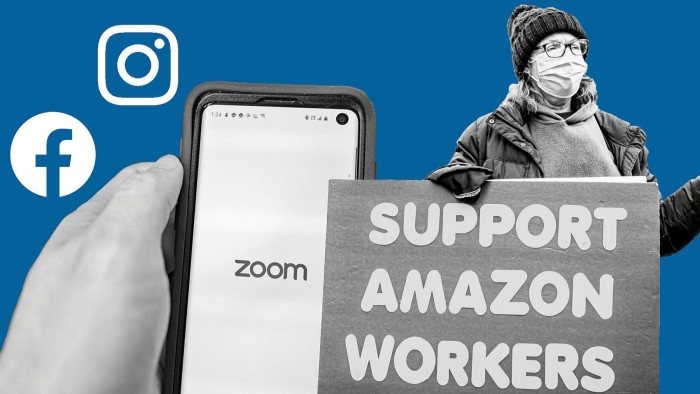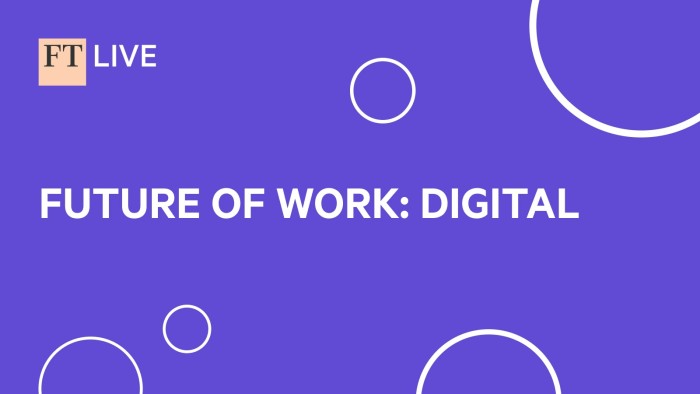Pandemic spurs trade unions to harness power of social media

Roula Khalaf, Editor of the FT, selects her favourite stories in this weekly newsletter.
Amazon was praised early in the pandemic for its hyper-efficient delivery services — but, behind the scenes, its workers were struggling.
“At the beginning it was chaos,” says Jesica Sobrino, who works as a “problem solver” at an Amazon warehouse in Barcelona, and was among the trade union members who pushed the company to introduce social distancing, mask requirements and temperature controls.
However, one side effect of the safety measures was “more distance between workers and less communication”. Face-to-face contact between union representatives and their members virtually disappeared.
“We had to reinvent the way we informed workers of their rights,” Sobrino says, explaining that the relatively low average age of her hub’s 4,000-plus workers made the local branch of union Comisiones Obreras opt to communicate via an Instagram. Its followers on the social media platform grew from 800 to 2,300 within eight months.
Sobrino and her colleagues’ experience is one example of how unions around the world have rapidly increased their engagement with members by switching to a digital-first approach to communications.
Unions in Finland, Romania and the Czech Republic have used phone calls, online group meetings and private Facebook pages to engage and survey members. The UK’s National Education Union got 70,000 members to join a Zoom call earlier this year, according to the International Trade Union Confederation.
The Comisiones Obreras branch’s Instagram page is frequently updated with explanatory videos, infographics and a “Behind the smile” slot where Amazon workers share problems that affect them in the workplace. It also uses the platform’s Stories feature, where it can run polls and workers can raise issues through private messages.
Interest in unions has also been boosted by unprecedented challenges for both frontline workers, who face the risk of infection by going into a workplace, and desk-bound employees, who have had to remodel their homes into fit-for-purpose workspaces.
Christy Hoffman, general secretary of Uni Global Union, which represents more than 20m workers in 150 countries, says the pandemic has “accelerated the use of lots of technology that will remain with us for forever”.
She says it is common to hear of union meetings drawing many more attendees when they are held online — up to 10 times as many as in-person gatherings — because they are so much easier to join.
But, while worker participation in meetings “has been expanded to a point that we have never seen before”, which she welcomes, she notes that it comes amid a “terrible tragedy and workers are suffering”.
And there are challenges. “At the end of the day, you have to have some face-to-face contact,” Hoffman says, “especially if you are organising in fearful environments where you have to build trust.”
Union outreach varies
A recent study by Bia Carneiro and Hermes Augusto Costa from the University of Coimbra in Portugal found that, despite the possibilities of digital communications, trade unions had stuck to an “outdated ‘one-way’ model of communication, hindering opportunities to reach and engage with both union and non-union actors”.
Sharan Burrow, general secretary of the International Trade Union Confederation, says workers’ ability to engage with online union outreach varies globally because of uneven access to decent internet connections, smartphones and computers across the world.
“Equally the explosion of . . . remote working has posed new challenges for regulation of rights and conditions including safe workplaces,” she adds.
The Comisiones Obreras branch’s success with its Instagram page has created its own set of challenges, with union representatives aware that Amazon — which has faced scrutiny in many countries over allegations that it seeks to prevent workers from organising — can see all content shared. It can also identify who is engaging with that content.
“We know that HR people follow all our content . . . they even called a meeting and asked us to be less hurtful with the company in our Instagram, but obviously we said no,” says Víctoriano Mauriño Medero, a colleague of Sobrino and head of their chapter.
New FT Live event

FT’s Future of Work event series is back this October. Join Facebook, LinkedIn, AstraZeneca, Nasa, and more as they explore key themes such as omnichannel workplaces, the impact of AI on jobs, privacy and security issues in distributed workforces. To book tickets, visit here
Amazon said in a statement: “Our employees have the choice of whether or not to join a union. They always have.”
To Sobrino, it was necessary to take the risk of engaging with members in public digital spaces, because unions have to “reinvent new ways to reach all people through the existing media, as these are very present in our lives. In no case will we abandon face-to-face trade union action. But we do see the need to complement this through social media.”

Comments